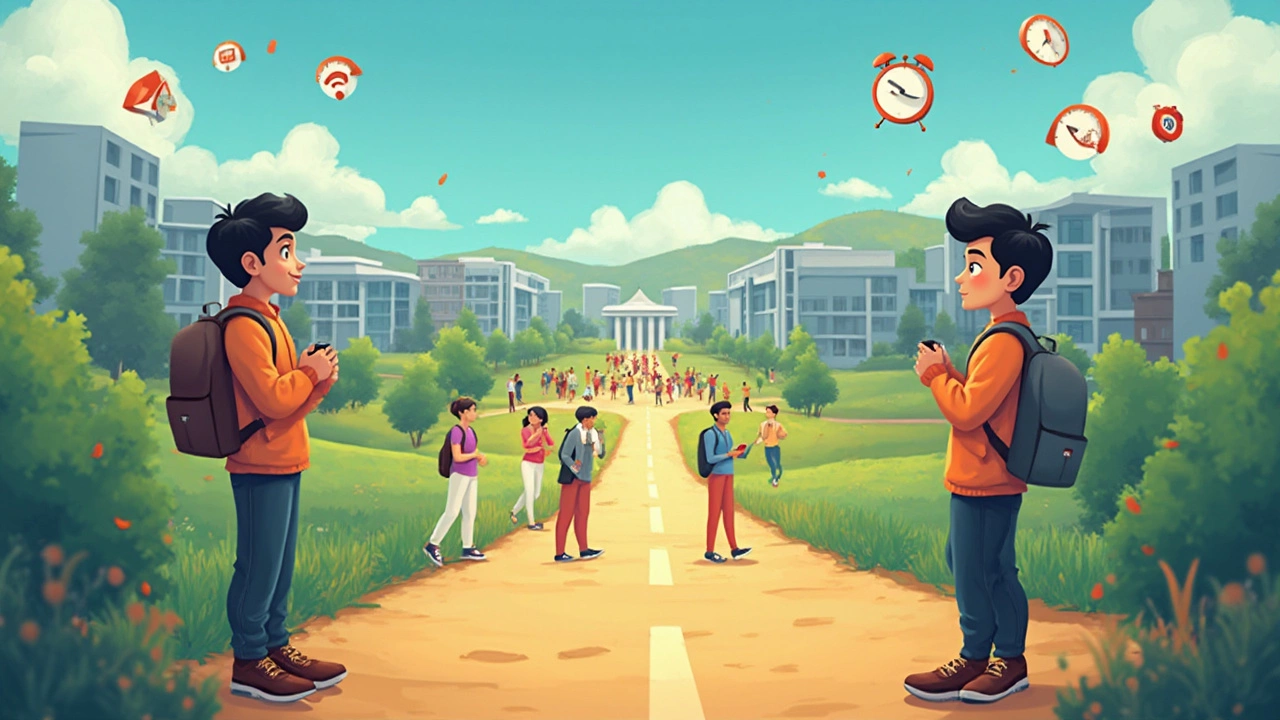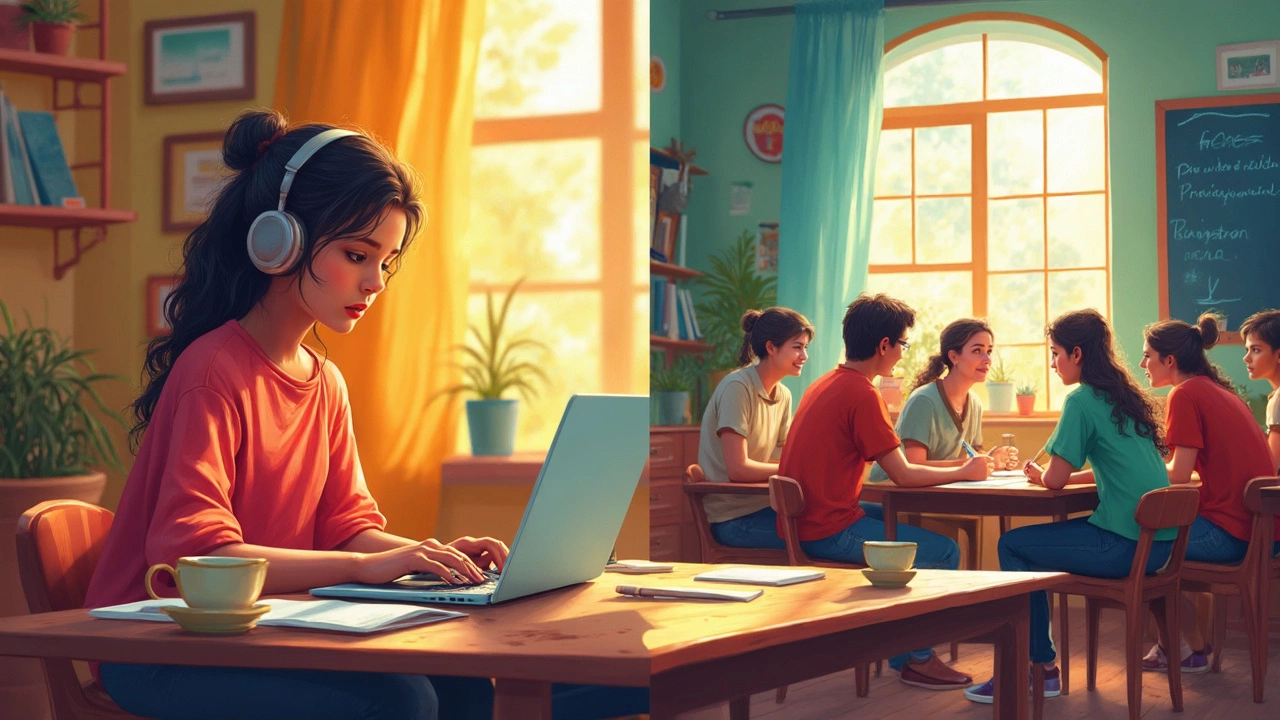Ever find yourself torn between signing up for an online course or joining a regular classroom? You’re not alone. Some people swear by distance learning because they can study at midnight in pajamas. Others need the energy of a room full of people and a teacher right in front of them. Both options have real advantages—and real headaches.
If you’re wondering which one actually works better, think about this: distance learning exploded in popularity when people realized they could save hours on the commute and still score good grades. Yet, a survey from last year showed that around 35% of students miss the structure and social life of a physical classroom. There’s no universal answer, but there’s definitely a “better” option for you depending on your personality, schedule, and goals.
Let’s strip away the hype and talk about how distance learning really compares to the good ol’ classroom. You’ll get the inside scoop on what actually happens day-to-day, so you won’t waste time on whatever doesn’t suit your lifestyle.
- What Is Distance Learning, Really?
- Classroom Vibes: More Than Just a Desk
- Key Benefits and Drawbacks: Head-to-Head
- Who Thrives Where?
- Smart Tips to Decide What’s Right for You
What Is Distance Learning, Really?
When people talk about distance learning these days, they usually mean any kind of distance learning where you don't sit in a physical classroom. You could be watching live lectures online, following pre-recorded videos, or tackling assignments in your own time using a portal. It's not just about college courses, either—everything from basic school lessons to advanced tech bootcamps can be done this way.
The biggest shift happened around 2020, when schools worldwide went online due to the pandemic. What’s wild is that the technology isn’t new—correspondence courses have existed since the 1800s, and by the late ‘90s, you could already earn full degrees through the internet. But now, nearly every university offers online programs, and over half of working adults say they’ve taken some online course in the past year.
Here's the deal: distance learning comes in different flavors. Sometimes you’ll need to log in at set times for live classes (called synchronous), and other times you can complete work whenever you want (asynchronous). Some programs try to recreate everything online—group projects, quizzes, even office hours with teachers.
- Flexibility: Study anywhere there’s Wi-Fi, save on travel, and balance other life stuff like work or family.
- Tech Tools: Platforms like Zoom, Google Classroom, and Moodle are the main hangouts. Everything—notes, homework, tests—is online.
- Solo Style: You’re in charge of keeping up. No one’s taking attendance or checking if you zoned out.
The main thing to remember? Not all distance learning is created equal. Some courses have live tutors and active discussions, others dump all the material at once and leave you to figure it out. Take a close look at a program’s structure before jumping in—especially if you know you need a little push to stay on track.
Classroom Vibes: More Than Just a Desk
Walking into a physical classroom is about a lot more than sitting behind a desk and listening to a lecture. There’s something about sharing a space, making eye contact with your classmates, and having a teacher right there to fire off questions to. That in-person energy can boost motivation and make lessons stick longer, especially for students who learn best through interaction.
You don’t just pick up facts; you learn how to work with others. Group projects, live debates, and those side conversations before class can help you develop people skills that are tough to get from behind a screen. Even the simple act of walking into a room with regular schedules sets a routine, which often makes it easier to stay focused.
“The social context of classroom learning helps develop lifelong skills such as communication, collaboration, and critical thinking, which are harder to foster online,” says Dr. Rashmi Nair, education consultant at Indian Institute of Education.
The face-to-face format also makes it easier for teachers to spot when you’re struggling. If you’re confused or falling behind, it usually gets noticed quickly—so you get help faster, often before things snowball.
- Immediate feedback from teachers—hands go up, answers come back in seconds.
- Peer learning goes beyond textbooks—study groups, instant support, and even friendly competition.
- Extracurricular clubs and activities spark new interests and build confidence.
| Classroom Factor | Chance to Experience In-Person |
|---|---|
| Group Discussions | High |
| Real-Time Teacher Support | High |
| Routine Structure | High |
| Hands-On Activities (like labs) | Very High |
Of course, a classroom education usually comes with fixed schedules, travel time, and less flexibility, but if you crave structure, new friends, and a teacher you can walk right up to—it’s hard to beat the classic classroom vibe.

Key Benefits and Drawbacks: Head-to-Head
If you line up distance learning against classroom education, the differences jump out pretty fast. Here’s how they stack up on things that actually matter.
- Flexibility: Distance learning lets you build a schedule around your life—your job, your family, even your nap time. That’s huge for folks who can’t drop everything for a class at 10 a.m. On the flip side, classrooms run on set schedules. If you’re late, you miss out.
- Social Interaction: It’s pretty hard to beat face-to-face vibes. In a classroom, those spontaneous chats and group projects push you to stay involved. With online classes, you can end up feeling alone unless you actively hop on forums or chat groups.
- Access and Convenience: Online? Anywhere you’ve got Wi-Fi is fair game—even the back seat of a car. With classrooms, you have to show up in person, which means dealing with traffic and travel expenses.
- Learning Support: In-person teachers can spot when you look confused and help right away. Online, you might be stuck waiting for an email reply or digging through help forums.
- Self-Motivation Needed: Distance education tests your self-drive. According to an Open University study in 2023, drop-out rates for distance learners were almost 15% higher than for classroom students, mainly because people struggled to keep themselves on track.
| Factor | Distance Learning | Classroom |
|---|---|---|
| Flexibility | High | Low |
| Social Interaction | Low | High |
| Costs | Usually Lower | Higher (fees, transport) |
| Direct Help from Teachers | Less Immediate | Instant |
| Self-Discipline Needed | High | Medium |
One thing people forget: tech glitches. If your Wi-Fi dies in the middle of an important lecture online, you’re stuck. But in a classroom, it’s mainly good old chalk and talk. Still, if you’re dealing with a busy schedule, distance education can be a game-changer—just know staying on top of things is all on you.
Who Thrives Where?
Some people just click with distance learning, while others come alive in a classroom. It mostly comes down to your habits, motivation, and what you want out of education. Here’s what the research and experience show:
- Self-Starters: If you’re the type who does things without being reminded, you might love distance learning. It’s all about managing your own schedule, and if you’re the kind who hates being micromanaged, studying online gives you that room. A study by Coursera in 2023 found that students with strong time management skills were 40% more likely to finish online courses successfully.
- Social Learners: If you get a boost from group discussions and hanging out with classmates, classroom education usually delivers more energy. It’s easier to raise a hand, get feedback, and stay focused when you’re in a group.
- Tech-Savvy Folks: Distance learning relies a lot on computers and the internet. If you’re comfortable figuring out new apps or troubleshooting issues now and then, that’s a big plus.
- People Needing Structure: If you struggle to get started without a set schedule, classrooms win. They give you a clear routine: go here, sit there, listen now. Some folks really need that push.
- Those With Busy Lives: If your schedule is packed or unpredictable—like parents, shift workers, or people balancing several jobs—distance learning often fits better. You can pause a lesson for a phone call or pick back up at night.
Want to see how it plays out in real life? Here’s a simple comparison based on what actual students reported:
| Type of Learner | Best Fit | Why It Works |
|---|---|---|
| Independent, organized | Distance learning | Flexible schedule, less interruption, more control |
| Likes interaction, needs guidance | Classroom | Instant support, group activities, regular timetable |
| Lives far from campus, travels often | Distance learning | No commute, learn from anywhere |
| Struggles to focus at home | Classroom | Fewer distractions, clear boundaries |
People sometimes switch between methods as life changes. After Ananya and I had our first kid, classroom sessions just didn’t fit anymore. Distance learning became the only way for us to keep moving forward—naptimes turned into study sessions. So, the best pick isn’t the same for everyone, and it can even change year to year.

Smart Tips to Decide What’s Right for You
Picking between distance learning and classroom education isn’t just flipping a coin. You’ll want to match your habits, personal needs, and future plans with the realities of each format. Here are some straight-up tips and facts to figure out which path fits your life right now.
- Think about your routine. Are you the type to stick to your own schedule, or do you need someone pushing you along? Distance learning gives you freedom, but you have to be super self-motivated. A classroom gives you structure with set times and deadlines.
- Check your tech comfort zone. To really do well at distance learning, you need reliable internet, a decent laptop, and basic tech skills. If tech glitches stress you out, a classroom could be less hassle.
- List out your distractions. Home might seem cozy, but it’s full of interruptions—family, snacks, your phone. Classrooms cut those out, so you stay on task. According to a 2023 survey from Statista, 47% of distance learners said distractions at home hurt their focus at least once a week.
- Think about why you’re studying. If you need lab space, group work, or hands-on activities, classrooms usually win. But if your main goal is learning theory or getting a certification for work, online options tick the box.
- Look at your budget and time. Traveling to campus adds up—both money and hours. In India, students who pick distance learning save on average ₹8,500 per year in transportation and extra books.
Data doesn't lie—so here’s a quick comparison:
| Factor | Distance Learning | Classroom |
|---|---|---|
| Flexibility | High | Low |
| Direct Interaction | Limited | High |
| Self-Discipline Needed | High | Medium |
| Costs | Often Lower | Varies, Often Higher |
| Hands-On Experience | Limited (unless blended or hybrid) | Much Greater |
Want help deciding now? Try this quick checklist:
- If you work or have family responsibilities, distance learning gives way more freedom.
- If you like meeting classmates and learning face-to-face, the classroom will probably feel more satisfying.
- If you can easily motivate yourself and stay focused, distance learning might be a breeze for you.
- If you struggle to keep up without reminders, classroom education can keep you on track.
No shame in picking what works best for you—there’s no one-size-fits-all in education. Test the waters with a short online course or a weekend class before you commit, and don’t let anyone else’s choice pressure you into something that just isn’t your vibe.

